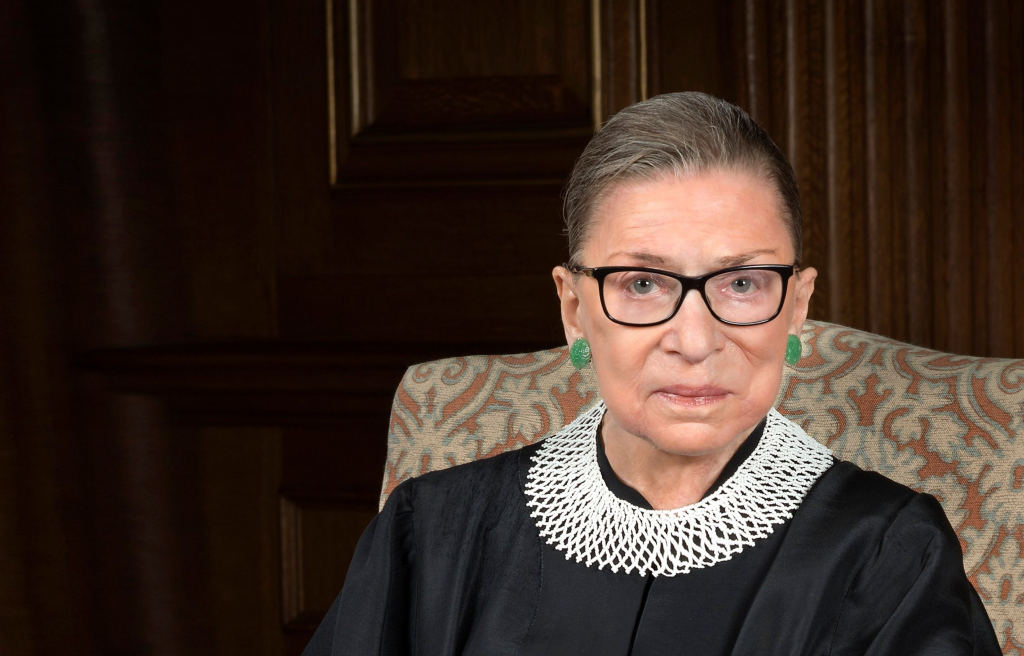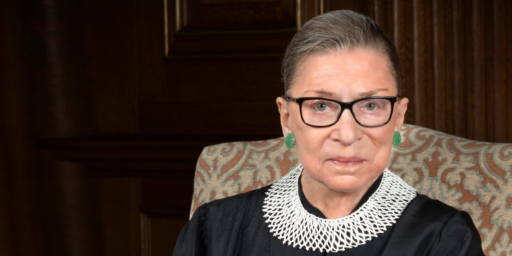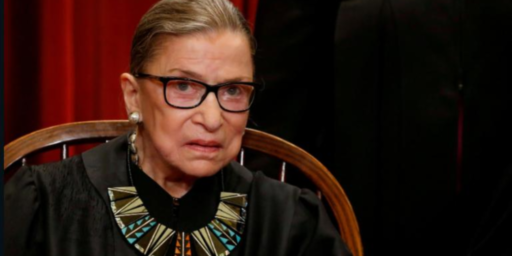Ginsburg Misses Oral Argument For First Time Since Taking The Bench
For the first time in her twenty-five years on the Supreme Court, Ruth Bader Ginsburg is missing oral argument this morning.

Shortly before the Supreme Court was scheduled to take the bench for the first day of January oral argument, the Supreme Court announced that Associate Justice Ruth Bader Ginsburg would be missing for at least today’s arguments:
Justice Ruth Bader Ginsburg will not be on the bench Monday when the Supreme Court hears oral arguments, the first time in her career she has missed a session.
Ginsburg, who joined the court in 1993, will participate in the scheduled cases by reading briefs and a transcript of the two oral arguments scheduled for Monday, court spokeswoman Kathleen Arberg said..
Ginsburg, 85, had surgery Dec. 21 for two malignant nodules in her left lung, the 85-year-old justice’s third bout with cancer.
The pulmonary lobectomy was performed at Memorial Sloan Kettering Cancer Center in New York. She was released several days later, and has been working at home, according to Arberg.
The two nodules in the lower lobe of her left lung were discovered during tests performed at George Washington University Hospital after Ginsburg fell and broke three ribs on Nov. 7.
In a pulmonary lobectomy, a lobe of the lung is completely removed. The right lung has three lobes, the left has two.
Ginsburg was treated for colorectal cancer in 1999, and pancreatic cancer was discovered at a very early stage 10 years later. She scheduled treatment for both during the court’s off days, and has not missed a day of oral argument.
Near the end of 2014, she had a heart stent implanted.
When Ginsburg had her surgery shortly before Christmas, it was announced that her plan was to be back on the Court today when oral argument resumed. When she was released from the hospital less than a week later, it seemed as though she was well on the way toward being able to achieve that goal. The fact that she is not on the bench today is newsworthy because it indicates that her recovery has been slower than perhaps she expected or hoped it would be and that working from home would be best for her. There’s no indication in the statement from the Supreme Court for any reason for the decision, nor is there any indication that we should conclude from this that her recovery has suffered a setback or that she has taken a turn for the worse. Additionally, the fact that she is apparently still able to still take part in the case by reading the oral argument transcripts, which is permitted under the Court’s rules, indicates that she may simply need additional time to fully recover.
It isn’t entirely unusual for a Justice to miss a day or two of oral argument here and there, and it’s more common for them to miss a court session in June when the Court is issuing opinions but not sitting for oral argument. That being said, this is significant because it marks the first time since taking the bench twenty-five years ago that Ginsburg has ever missed a day of oral argument, and that includes the two previous occasions on which she underwent far more serious surgeries related to colorectal cancer in 1999 and pancreatic cancer in 2009. Of course, when those surgeries occurred she was younger than her current age of 85, and wasn’t at the same time recovering from a fall in which she suffered cracked ribs, which actually turned out to be fortunate in some respects in that the X-Rays taken in connection with her injuries are what led doctors to discover the nodules removed in December. Taking all that into account, the fact that it’s taking Justice Ginsburg a bit longer to recover isn’t surprising.
Today, the Court is scheduled to hear oral argument in two cases, one of which deal with issues of whether or not certain state laws are pre-empted by regulations from the Food and Drug Administration and the interpretation of the Fair Debt Collection Practices Act. Tomorrow and Wednesday, the Court is scheduled to hear argument in cases dealing with Native American hunting rights, Copyright law, and a somewhat complicated case involving competing jurisdictional claims between Nevada and California. After that, there is a second week of oral argument set for next week. None of the cases set for argument in January are considered “high profile” cases, which is perhaps one reason why Ginsburg chose to exercise the option of working from home.
It’s not clear from today’s news from the Court if Justice Ginsburg will be back on the bench tomorrow, or if she will require additional time to recover at home. Whatever the news, the significance of all of this and what it might mean for Ginsburg’s longer-term health and her ability to stay on the bench as long as she intends is unclear. Hopefully, though, this is simply a case of ‘better safe than sorry’ on her part and that we’ll see her back to her usual self in a short period of time.



I’m worried she may not outlast El Cheeto.
It’s way past time to reform the Court, either by laying down term limits, increasing the number of Justices, or both.
Perhaps a gradual reform imposing term limits with the option of renewing them once. Say a fifteen year limit, giving the sitting president, or even Trump, at the time of expiration the option to renew it for another fifteen years.
Term limits would require a Constitutional Amendment.
@Doug Mataconis: This is both true and not an argument for or against.
Let us hope for her swift and complete recovery and a long and fiesty life.
IANAL, a hypothetical question – what happens if a Justice is unable to carry out his or her duties but does not resign? Are there Court rules that are enforceable? Is there any path to removal except impeachment by the Senate? If so, does it require a majority or 2/3?
@Steven L. Taylor:
Merely pointing out that as a practical matter it is much easier said than done.
Stay strong, RBG…your country needs you.
@Doug Mataconis: I get that, but it is a pet peeve of mine because, to be blunt, it is a lazy response. I get that it is hard (it is practically impossible at the moment), but if we just say “that would be hard” we end up not having the full discussion that might make an outcome possible.
@gVOR08:
There is no way to remove a Justice who may be incapacitated other than by impeachment. This was last an issue in the early 70s with Justice William O. Douglas, who was near dementia before retiring. This is also true of Congressmen, Senators, and the Vice-President.
Section 4 of the 25th Amendment only applies to the President.
@Steven L. Taylor:
I understand what you’re saying, and I have discussed the issue of term limits in the past and I know you have as well. Personally, based on my experiences in the court system, I think the value of the independence that lifetime tenure provides to the Federal Judiciary far outweighs any negative consequences. That, however, is largely a matter of opinion I think.
In any case, the point of my response to Kathy was to simply note the fact that what she was proposing would not be simple to put in place and I think that is something worth considering when one is considering these political reform ideas from a practical rather than a theoretical point of view.
The other idea — increasing the size of the Supreme Court — could admittedly be accomplished via legislation but I tend to believe it’s impractical. We’ve expermented with different sizes for Court membership and settled on 9 sometime in the 19th Century. For the most part, I think this is close to the point where you reach the largest size an appellate court should be in order to be able to function effectively. Too small a membership means it’s easier for one ideological side to dominate the other. Too big a membership makes effective functioning difficult logistically. We see the later in the 9th Circuit, which is so large at this point that when it sits “en banc” that doesn’t really mean every active member of the Court (which has 29 judges) is participating, Instead, they designate a panel of nine members of the Court to represent the Court en banc and review the three-judge panel decision.
@Doug Mataconis:
Everything is easier said than done.
Even saying “I think this reform would work,” without thinking through all aspects or looking at possible consequences. For example, making terms renewable, even once, can interfere with the court’s independence (it’s obvious).
Or not considering that the current partisan divide can’t last indefinitely, and that making a reform to fix the consequences of the divide may not be the best solution.
@Kathy:
I’m not saying we can’t or shouldn’t discuss possible reforms, but I do think that one has to consider how likely it is that those reforms can be adopted as a practical matter. But then I come at these issues from a practical rather than a theoretical point of view.
@Doug Mataconis: What if she just vanishes? How quickly can they replace a Supreme Court justice who has not been declared officially dead, but isn’t showing up to work or anywhere else.
I’m thinking we might need a plan to hide the body. Just as a backup, in case she doesn’t live until 2021.
We will also need some RBG impersonators, to be seen here and there across the country, and we will need to collect some of her hair, to leave DNA evidence of her continued existence during the manhunt.
I *think* we would just need thirty some odd Democratic Senators to vote against her impeachment for job abandonment.
I hope that she is healthy and fine, and lives for many years, but this might be one of those situations that can best be handled through madcap adventures.
Well, if Ginsburg holds out for another year and doesn’t retire until 2020, the GOP Congress will certainly hold that seat open until after the election, so that the American people can have a say in … pfft … hahaha. No, I can’t type that with a straight face.
So in other words, her presence was felt about as much as that of Clarence Thomas…
” I think the value of the independence that lifetime tenure provides to the Federal Judiciary far outweighs any negative consequences. ”
Would they be any less independent if they had a defined term? Lets say instead of lifetime they get 12 years with no chance of re-appointment. Cant see why they would be less independent.
Steve
Progressives can not even give her thoughts and prayers.
The Constitution says that John Paul Stevens must replace her if she dies until after the next Presidential election.
It is in shadows and penumbra. part that says illegal alien have Constitutional superior rights therefore DACA is the law.
Well, that’s about as ridiculous as holding a seat open until a Republican gets elected president…
So sorry that most people aren’t as heartless and as cold-blooded as you are about the Dreamers…what a shame that more people don’t just want to throw them out…